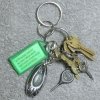I could be wrong but it seems like a good many folks say they do not like a thumb safety on their firearm. My uncle is a LEO and he scoffs at any gun with a safety-he wont even consider having a gun with one..
Ask him about his deluxe dept. issue holster. Most likely he had to take a class on its operation alone. And, a LEOs holster is nothing about concealment, but the contrary!! These holsters cost around $100 with dept discount. LEO holsters are a safety device in themselves, with 2 or 3 things that must happen before the pistol can be drawn; the holster is an external safety. Why??? And this will be the basis for most of my following comments....No dept wants an officers pistol taken (unauthorized use), and ultimately used against them.
Also, i've heard a lot of people say they do not like a magazine disconnect safety either.
I agree, in fact thats a fleeting issue with current manufactures as far as I've seen.
I know the safety "between your ears" is the most important but
why do some folks not like safety features such as these, especially since you can choose to just not use the thumb safety if you have one? Am i missing something here? (FYI i'm still new at this so its quite possible that yes, i am missing something here).
IMHO, lack of training or, fortunately,lack of real life encounters. Again I state that, dept issue pistols...regardless of manufacturer...are now mated to a level two or three holster. F.Y.I. that means, 2 or 3 things have to be pushed, tugged, etc before the pistol will come out.
Then off duty LEOs take that same pistol i.e. GLock, and put it in an open carry / concealed holster you're asking for potential unauthorized use. If a thug whacks you in the head you will be disoriented for seconds...don't get shot with your own gun. Also ask your LEO friends if they're trained to 1)disarm an armed attacker and 2) recover their pistol (if its any type of dept), the answer will be ''yes''. Why??
Between your ears...remember...in a real encounter you will be acting defensively. The perp will be the aggressor...offensively. If the perp takes your gun from you (its actually easier then you think) and he's taking several seconds (he's already in offensive action status)jerking on the trigger instead of disengaging the safety, you have that same time to respond, flee, etc.
If you do decide to carry a firearm with/without a physical external safety I strongly suggest a concealment holster with some type of retention device, preferably a lever/button to push and not simply a snap. I also suggest training drawing your pistol, returning to holster, repeat. I also suggest further training in weapons retention & situational awareness i.e. an NRA approved course.
BTW,the big "G" doesn't condone carrying their pistol with a chambered round. So says their instructional manual.With all those internal safeties, why??
Hope that helps some!



